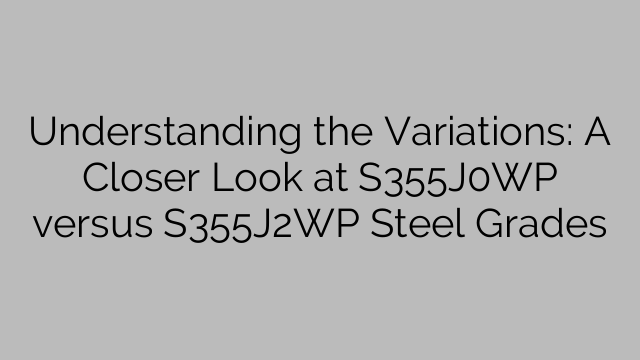Understanding the Variations: A Closer Look at S355J0WP versus S355J2WP Steel Grades
In the world of steel grades, it can often be confusing to navigate through the vast array of options available. Two such grades that are often compared are S355J0WP and S355J2WP. While they may seem similar at first glance, there are distinct differences that make each grade unique. In this article, we will delve deeper into these variations to help you understand their individual characteristics and applications.
Both S355J0WP and S355J2WP are atmospheric corrosion-resistant steels that belong to the EN 10025-5 standard. This standard specifies the technical delivery conditions for structural steels with improved atmospheric corrosion resistance. These grades are designed to be used in structural components exposed to outdoor environments, where the steel is subject to the corrosive effects of moisture, air, and other atmospheric elements.
S355J0WP is a structural steel grade with a minimum yield strength of 355 MPa. It offers excellent corrosion resistance due to its alloying elements, primarily copper and phosphorus. These elements form a protective patina on the surface of the steel, which acts as a barrier against further corrosion. S355J0WP is primarily used for welded, bolted, and riveted structures in bridges, buildings, and other outdoor applications.
On the other hand, S355J2WP is an improved version of S355J0WP, offering higher yield strength of 355-510 MPa. It also contains alloying elements such as copper, phosphorus, chromium, nickel, and molybdenum, which enhance its corrosion resistance properties. This grade is particularly suitable for applications where good weldability and increased resistance to atmospheric corrosion are required, such as in offshore structures, shipping containers, and architectural components.
While both grades share similar corrosion resistance properties, the key difference lies in their mechanical properties. S355J2WP possesses superior mechanical strength, making it more suitable for load-bearing structures subjected to higher stress levels. Additionally, the presence of chromium, nickel, and molybdenum in S355J2WP provides added protection against pitting corrosion, making it a preferred choice for applications where the steel may come into contact with highly corrosive substances.
It is important to note that both S355J0WP and S355J2WP grades offer excellent resistance to atmospheric corrosion. However, the choice between the two depends on the specific requirements of the application. Factors such as mechanical strength, weldability, and exposure to harsh environments should be considered when selecting the most appropriate grade.
Moreover, when using either grade, proper surface preparation and protective coatings are crucial to prolonging the lifespan and maintaining the corrosion-resistant properties of the steel. Regular maintenance, inspection, and applying suitable anti-corrosion measures are necessary to ensure the longevity of structures constructed with these grades.
In conclusion, S355J0WP and S355J2WP are two atmospheric corrosion-resistant steel grades that offer excellent resistance to the corrosive effects of the environment. While both grades share similarities, S355J2WP offers higher mechanical strength and enhanced resistance to pitting corrosion due to its additional alloying elements. The choice between the two depends on the specific application requirements, emphasizing the need for careful consideration and expert consultation during material selection.

